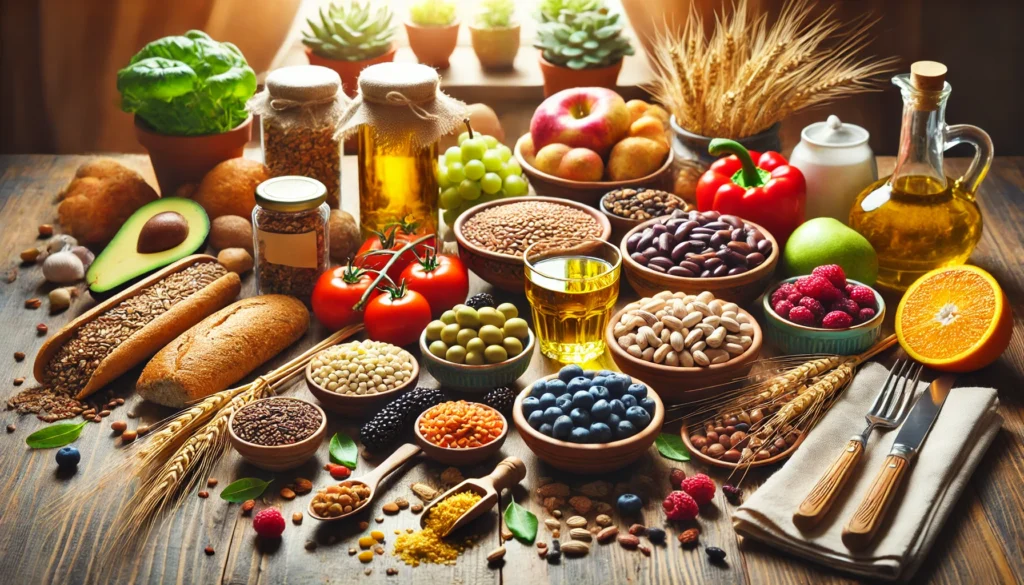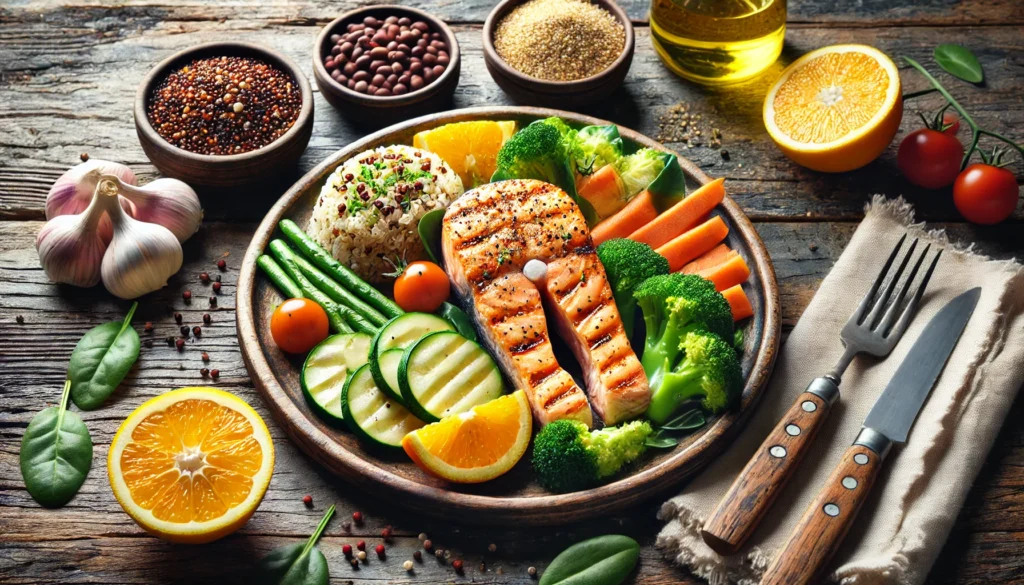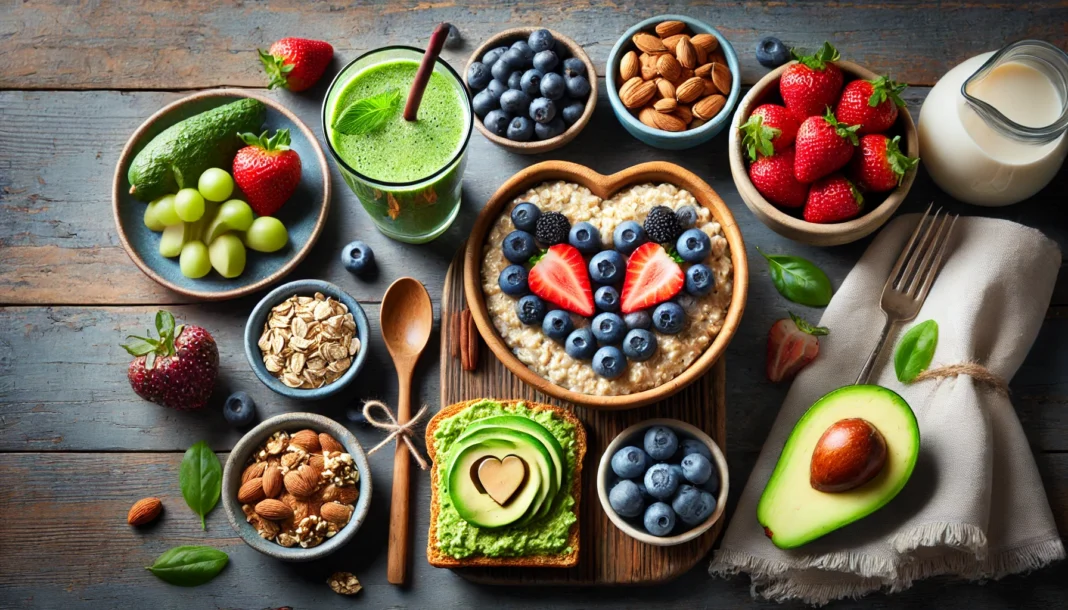Introduction: The Importance of Nutrition in Post-Heart Attack Recovery
Recovering from a heart attack is a multifaceted process that involves medical treatment, lifestyle adjustments, and, crucially, a well-balanced diet. Nutrition plays an integral role in the healing process, supporting cardiovascular function, reducing inflammation, and helping prevent future cardiac events. For individuals who have undergone interventions such as a stent placement, dietary choices can be particularly impactful in maintaining heart health and preventing further arterial blockages. Understanding what can people eat after a heart attack is essential for both immediate recovery and long-term wellness.
You may also like: The Ultimate Heart-Healthy Diet Plan: Best Foods to Support Recovery After a Heart Attack
Dietary adjustments are not simply about eliminating unhealthy foods but also about actively incorporating heart-protective nutrients. The right food choices can improve cholesterol levels, regulate blood pressure, and support overall heart function. Since cardiovascular disease is a chronic condition, post-heart attack diet plans should not be viewed as temporary fixes but as long-term strategies for sustaining heart health. This guide explores the best foods for recovery, offering practical advice on how to nourish the body effectively and make informed dietary choices for a healthier future.

Understanding Nutritional Needs After a Heart Attack
After experiencing a heart attack, the body undergoes a healing process that requires specific nutrients to repair damaged tissues and strengthen the cardiovascular system. A heart-healthy diet focuses on reducing saturated fats, trans fats, and sodium while increasing fiber, lean protein, and heart-protective compounds such as omega-3 fatty acids and antioxidants.
A common concern is diet after heart attack stent placement, as individuals with stents need to maintain clear arteries to prevent future blockages. Adopting a Mediterranean-style diet, rich in vegetables, whole grains, lean proteins, and healthy fats, has been widely recommended for its cardiovascular benefits. Additionally, hydration and electrolyte balance are crucial components of recovery, as they help regulate blood pressure and support overall circulatory function.
Moreover, inflammation plays a significant role in heart disease progression, making it essential to consume foods with anti-inflammatory properties. Incorporating foods rich in polyphenols, flavonoids, and vitamins such as C and E can help reduce oxidative stress, which contributes to arterial damage. By understanding these nutritional requirements, individuals can tailor their diets to maximize recovery and prevent complications.

Best Foods for Heart Attack Recovery
1. Fruits and Vegetables: Nutrient-Dense and Antioxidant-Rich
Fruits and vegetables are cornerstone components of any post-heart attack diet due to their high levels of vitamins, minerals, fiber, and antioxidants. These nutrients help reduce inflammation, lower blood pressure, and support vascular health. Leafy greens such as spinach, kale, and Swiss chard are particularly beneficial due to their nitrate content, which aids in vasodilation and improved blood flow.
Berries, including blueberries, strawberries, and raspberries, are rich in anthocyanins, powerful antioxidants that help reduce oxidative stress and lower the risk of further cardiovascular damage. Citrus fruits provide vitamin C, which supports collagen production and strengthens arterial walls. Consuming a variety of colorful vegetables ensures a broad spectrum of nutrients essential for heart health.
2. Whole Grains: Fiber for Cholesterol and Blood Sugar Control
Whole grains such as oats, quinoa, barley, and brown rice are excellent sources of dietary fiber, which helps regulate cholesterol levels and maintain stable blood sugar. Unlike refined grains, whole grains retain their nutrient-rich bran and germ, offering more significant cardiovascular benefits. Soluble fiber, found in oats and barley, helps reduce LDL (bad) cholesterol by binding to it in the digestive tract and promoting its excretion.
Incorporating whole grains into meals can also provide steady energy levels, preventing blood sugar spikes that may contribute to inflammation and metabolic issues. Individuals concerned about what to eat after a heart attack fast food options should consider replacing refined grains with whole grain alternatives to maintain heart-healthy dietary habits.
3. Lean Proteins: Building Blocks for Recovery
Protein is crucial for muscle repair and overall recovery following a heart attack. However, not all protein sources are created equal. Lean protein sources such as skinless poultry, fish, legumes, and tofu offer essential amino acids without the excess saturated fat found in red and processed meats.
Fatty fish like salmon, mackerel, and sardines provide omega-3 fatty acids, which reduce inflammation, lower triglyceride levels, and support endothelial function. Plant-based proteins such as lentils, beans, and chickpeas not only supply protein but also contribute to fiber intake, further benefiting cholesterol and blood sugar management.
4. Healthy Fats: Supporting Cardiovascular Function
Contrary to past dietary misconceptions, not all fats are harmful to heart health. Monounsaturated and polyunsaturated fats, found in olive oil, avocados, nuts, and seeds, support cardiovascular function by reducing LDL cholesterol and increasing HDL (good) cholesterol.
The Mediterranean diet, often recommended for individuals following a heart attack, emphasizes the consumption of healthy fats through olive oil and nuts. Walnuts, in particular, are rich in alpha-linolenic acid (ALA), a plant-based omega-3 that offers heart-protective benefits.
5. Low-Fat Dairy: Calcium and Probiotic Benefits
Low-fat dairy products such as yogurt, kefir, and cottage cheese provide essential nutrients like calcium, magnesium, and potassium, which help regulate blood pressure. Fermented dairy products also contain probiotics that support gut health, an emerging area of interest in cardiovascular wellness.
While full-fat dairy should be consumed in moderation due to its saturated fat content, selecting low-fat or fat-free options allows individuals to reap the benefits of dairy without negatively impacting cholesterol levels.
6. Nuts and Seeds: Nutrient-Dense Snack Options
Nuts and seeds are excellent snack choices for those on a post-heart attack diet. Almonds, walnuts, chia seeds, and flaxseeds provide essential fatty acids, fiber, and protein while helping to regulate cholesterol levels. Studies have shown that regular nut consumption is associated with a lower risk of heart disease, making them a valuable addition to a heart-healthy diet.
Incorporating nuts and seeds into meals, such as adding flaxseeds to oatmeal or sprinkling almonds over salads, provides a convenient way to enhance nutrient intake while supporting cardiovascular function.
7. Hydration and Heart Health
Proper hydration is often overlooked in post-heart attack recovery but is essential for maintaining cardiovascular function. Water helps regulate blood viscosity, ensuring smooth circulation and preventing excessive clot formation. Herbal teas, such as green tea and hibiscus tea, offer additional cardiovascular benefits due to their antioxidant content.
Individuals should aim to consume adequate fluids daily while limiting high-sugar and caffeinated beverages that may contribute to dehydration or blood pressure fluctuations.

Frequently Asked Questions (FAQ) About Diet After a Heart Attack
1. How soon after a heart attack should dietary changes begin?
Dietary changes should ideally begin as soon as a person is medically stable following a heart attack. The first few days post-heart attack are critical for recovery, and consuming the right foods can help support healing while reducing strain on the heart. Many hospitals provide cardiac diet plans to guide patients in making better food choices before discharge. Long-term adherence to a heart-healthy diet is essential, particularly for individuals who have undergone stent placement. A proper diet after heart attack stent procedures can prevent complications such as restenosis (re-narrowing of the artery) and promote overall cardiovascular wellness.
2. Are there specific foods that should be avoided entirely after a heart attack?
Yes, certain foods should be limited or avoided entirely to prevent further cardiovascular damage. Processed meats such as sausages, hot dogs, and bacon contain high levels of sodium and saturated fats, which contribute to arterial plaque buildup. Fried foods, fast food, and packaged snacks often contain trans fats that increase bad cholesterol (LDL) while lowering good cholesterol (HDL). For those wondering what to eat after a heart attack fast food alternatives, choosing grilled options over fried ones, selecting salads with lean proteins, and avoiding excessive sodium can help make healthier choices. Sugary beverages and refined carbohydrates should also be minimized, as they contribute to inflammation and insulin resistance, both of which negatively impact heart health.
3. What role do omega-3 fatty acids play in heart attack recovery?
Omega-3 fatty acids are essential for reducing inflammation and supporting cardiovascular function after a heart attack. These healthy fats help lower triglyceride levels, improve arterial flexibility, and reduce the risk of future clot formation. Fatty fish such as salmon, mackerel, and sardines are excellent sources of omega-3s and should be included in a post heart attack diet at least twice a week. For individuals who prefer plant-based options, flaxseeds, chia seeds, and walnuts provide alpha-linolenic acid (ALA), a plant-based omega-3 that offers similar benefits. Additionally, omega-3 supplementation may be considered for those who do not regularly consume fish, but this should be discussed with a healthcare provider.
4. Can people eat dairy products after a heart attack?
Yes, but it is essential to choose dairy products wisely. Full-fat dairy products contain saturated fats that may contribute to higher cholesterol levels, increasing the risk of additional cardiovascular events. Low-fat or non-fat dairy options, such as skim milk, Greek yogurt, and cottage cheese, are better choices for those following a heart-healthy diet. Some fermented dairy products, like kefir and yogurt with probiotics, may also support gut health, which is increasingly being linked to cardiovascular well-being. If lactose intolerance or dairy sensitivity is a concern, plant-based alternatives such as almond or oat milk can be considered, but it is crucial to choose unsweetened varieties without added sugars.
5. What are the best sources of protein for someone recovering from a heart attack?
Protein is an essential nutrient for muscle repair and overall healing, but the source of protein matters significantly. Lean protein sources such as skinless poultry, fish, legumes, and tofu should be prioritized in a diet after heart attack stent procedures to minimize additional artery blockages. Fatty fish, such as salmon and trout, provide both high-quality protein and heart-healthy omega-3s. Plant-based proteins, including lentils, chickpeas, and quinoa, offer the added benefit of fiber, which helps with cholesterol management. While red meat can be consumed occasionally, it is best to opt for lean cuts and avoid processed meats that contain high sodium and preservative levels.
6. Is it safe to eat eggs after a heart attack?
Eggs can be included in a heart-healthy diet when consumed in moderation. While eggs contain dietary cholesterol, research suggests that their impact on blood cholesterol levels is less significant than previously believed. The key is to prepare them in a healthy manner, such as boiling or poaching, rather than frying in unhealthy oils. For individuals concerned about cholesterol levels, egg whites provide a high-protein, low-fat alternative. Combining eggs with vegetables and whole grains can enhance their nutritional profile, making them a valuable addition to a post heart attack diet without increasing cardiovascular risks.
7. Can people still eat out at restaurants after a heart attack?
Yes, but making informed choices is crucial to maintaining heart health while dining out. Restaurants often use excessive salt, unhealthy fats, and refined carbohydrates, which can be detrimental to heart attack recovery. Individuals should prioritize dishes that are grilled, steamed, or baked rather than fried. Requesting dressings and sauces on the side can help control sodium and calorie intake. For those wondering what to eat after a heart attack fast food options, choosing items such as grilled chicken sandwiches on whole-grain bread, salads with vinaigrette dressing, or veggie-based dishes can help maintain a heart-friendly diet while eating out.
8. How does fiber contribute to heart attack recovery?
Fiber plays a crucial role in heart health by helping to lower cholesterol levels, regulate blood sugar, and promote digestive health. Soluble fiber, found in oats, beans, and lentils, binds to cholesterol and aids in its excretion, reducing LDL levels. Whole grains, fruits, and vegetables provide insoluble fiber, which supports gut health and aids in digestion. Including a variety of fiber-rich foods in a post heart attack diet can improve overall cardiovascular function and reduce the risk of recurrent heart events. Additionally, fiber-rich foods help individuals feel fuller for longer, which can aid in maintaining a healthy weight and preventing overeating.
9. Are there any supplements that can help with heart attack recovery?
While food should be the primary source of nutrients, certain supplements may support cardiovascular health when used appropriately. Omega-3 fish oil supplements can help individuals who do not consume enough fatty fish in their diet. Coenzyme Q10 (CoQ10) has been studied for its potential to improve heart function, particularly in individuals taking statin medications. Magnesium and potassium supplements may benefit those with electrolyte imbalances affecting heart rhythm. However, it is essential to consult a healthcare provider before adding any supplements to a diet after heart attack stent placement to avoid interactions with medications or potential side effects.
10. How important is hydration in heart attack recovery?
Proper hydration is essential for maintaining optimal heart function and circulation. Dehydration can lead to thicker blood, increasing the risk of clot formation and high blood pressure. Drinking adequate amounts of water helps maintain electrolyte balance, supports kidney function, and prevents unnecessary strain on the cardiovascular system. Herbal teas, such as green tea or hibiscus tea, can provide additional antioxidant benefits while contributing to daily fluid intake. For individuals adjusting their diet after heart attack stent procedures, it is essential to monitor caffeine and alcohol intake, as both can have diuretic effects and impact hydration levels negatively.
By following a well-balanced diet, making mindful choices, and staying informed, individuals recovering from a heart attack can significantly improve their heart health and reduce the risk of future cardiac events.
Conclusion: Sustaining Long-Term Heart Health Through Nutrition
Adopting a heart-healthy diet is one of the most effective ways to support recovery and prevent future cardiovascular events. By focusing on nutrient-dense foods, lean proteins, healthy fats, and fiber-rich grains, individuals can actively improve their heart health and overall well-being. The question of what can people eat after a heart attack is best answered through a balanced, varied diet that prioritizes whole, minimally processed foods.
Maintaining these dietary habits beyond the immediate recovery period is crucial for long-term cardiovascular protection. Combining proper nutrition with regular physical activity, stress management, and medical adherence ensures a holistic approach to heart health. Whether recovering from a heart attack or looking to prevent one, making informed dietary choices can significantly impact quality of life and longevity.
heart-healthy foods, cardiac diet plan, foods for heart recovery, cardiovascular nutrition, healing after a heart attack, best diet for heart patients, heart attack recovery foods, cholesterol-lowering diet, anti-inflammatory foods for heart health, Mediterranean diet for heart health, healthy eating for heart disease, heart-friendly meals, cardiac rehabilitation nutrition, managing heart disease with diet, heart attack prevention foods, best protein sources for heart health, diet for better circulation, foods to reduce blood pressure, heart disease lifestyle changes, healthy fats for the heart
Further Reading:
Foods to Eat and Limit After a Heart Attack
What to Eat After a Heart Attack
Heart Attack Recovery and Rehabilitation
Disclaimer
The information contained in this article is provided for general informational purposes only and is not intended to serve as medical, legal, or professional advice. While MedNewsPedia strives to present accurate, up-to-date, and reliable content, no warranty or guarantee, expressed or implied, is made regarding the completeness, accuracy, or adequacy of the information provided. Readers are strongly advised to seek the guidance of a qualified healthcare provider or other relevant professionals before acting on any information contained in this article. MedNewsPedia, its authors, editors, and contributors expressly disclaim any liability for any damages, losses, or consequences arising directly or indirectly from the use, interpretation, or reliance on any information presented herein. The views and opinions expressed in this article are those of the author(s) and do not necessarily reflect the official policies or positions of MedNewsPedia.


